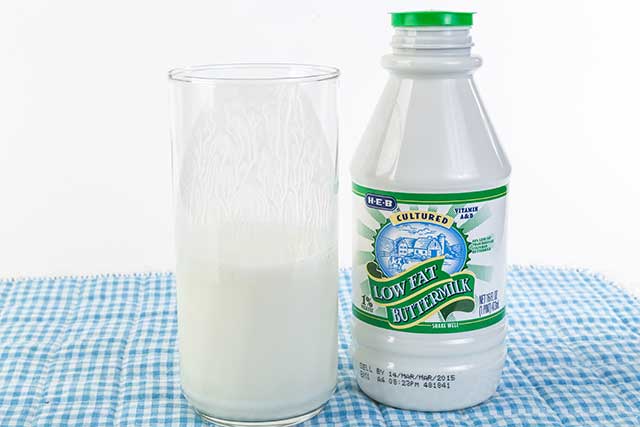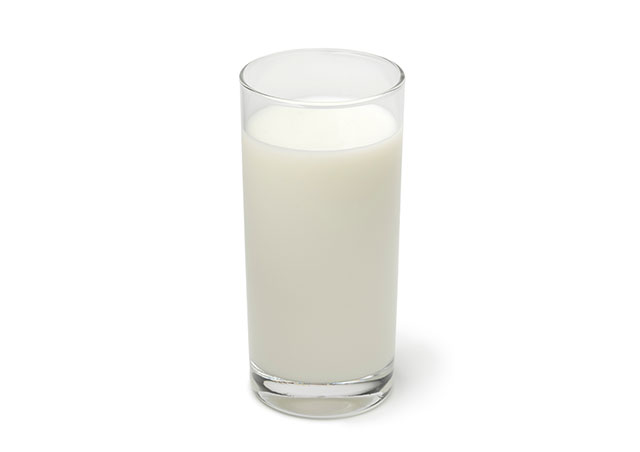What Is Buttermilk and Is It Good For You?
Buttermilk is a variety of milk that has been growing in popularity over recent years.
But is it good for you?
This article examines precisely what buttermilk is, the full nutrition profile, and its potential health benefits.
What Is Buttermilk?
The popularity of buttermilk experienced a deep decline until recent years.
These days, along with other dairy products like kefir, sales are up, and buttermilk is experiencing a resurgence.
Despite the confusing name, buttermilk does not contain butter, and it is not a high-fat dairy product.
Buttermilk is a type of dairy product that has a slightly sour taste, and it comes in two main varieties (1);
- Traditional buttermilk: the leftover liquid from the process of churning butter. It has a slightly acidic taste and, since the butterfat has been removed, it is very low in fat.
- Cultured buttermilk: a cultured milk product made by fermenting milk with lactic acid bacterial cultures. It is a rich source of probiotics.
Traditional butterfat has a long history, and it is still prevalent in South Asian countries such as India and Pakistan.
However, cultured buttermilk is the more popular of the two, and it is the norm in Western countries.
For this reason, this article will focus on cultured buttermilk.
How Is Cultured Buttermilk Made?
Generally speaking, low-fat milk is the default choice for the production of buttermilk.
However, it still offers about half as much fat as whole milk, as we will see in the nutrition facts section below.
After separating (some) cream from whole milk and then undergoing pasteurization, the milk goes through a fermentation stage.
First of all, the producers add some bacterial starter cultures to the milk.
Although there is a wide variety of different culture species, they typically include;
- Lactococcus lactis subspecies lactis
- Lactococcus lactis subspecies cremoris
- Leuconostoc citrovorum
- Leuconostoc mesenteroides subspecies mesenteroides
The next stage involves leaving the cultured milk to ripen and ferment.
For anyone curious, here is an in-depth guide to the production process of buttermilk.
Nutrition Facts
The following tables show the full nutrition profile of buttermilk per 100 ml.
The data source is the reliable NCC Food and Nutrient Database.
| Calories/Nutrient | Amount |
|---|---|
| Calories | 56 kcal |
| Carbohydrate | 5.3 g |
| Fiber | 0 g |
| Sugars | 5.3 g |
| Fat | 2.0 g |
| Saturated Fat | 1.2 g |
| Monounsaturated Fat | 0.6 g |
| Polyunsaturated Fat | 0.1 g |
| Omega-3 Fatty Acids | 30.0 mg |
| Omega-6 Fatty Acids | 40.0 mg |
| Protein | 4.1 g |
| Vitamin | Amount | % DV |
|---|---|---|
| Riboflavin (B2) | 0.21 mg | 12.4 % |
| Cobalamin (B12) | 0.37 mcg | 6.2 % |
| Thiamin (B1) | 0.1 mg | 3.3 % |
| Choline | 16.0 mg | 2.9 % |
| Pantothenic Acid (B5) | 0.28 mg | 2.8 % |
| Vitamin C | 1.50 mg | 2.5 % |
| Vitamin A | 16.3 mcg RAE | 1.8 % |
| Pyridoxine (B6) | 0.03 mg | 1.5 % |
| Folate | 6.0 mcg | 1.5 % |
| Niacin (B3) | 0.1 mg | 0.5 % |
| Vitamin E | 0.1 mg | 0.5 % |
| Vitamin D | 1.0 IU | 0.3 % |
| Vitamin K | 0.1 mcg | 0.1 % |
| Mineral | Amount | % DV |
|---|---|---|
| Calcium | 143 mg | 14.3 % |
| Phosphorus | 82.0 mg | 8.2 % |
| Potassium | 180 mg | 5.1 % |
| Sodium | 105 mg | 4.4 % |
| Selenium | 2.3 mcg | 3.3 % |
| Magnesium | 13.0 mg | 3.3 % |
| Zinc | 0.24 mg | 1.6 % |
| Copper | Trace | 0.4 % |
| Iron | 0.06 mg | 0.3 % |
| Manganese | Trace | 0.1 % |
Health Benefits
Buttermilk may have various potential health benefits.
Here is an overview of the beneficial aspects and findings from published research.
1) Studies Show Buttermilk May Reduce Blood Pressure
Interestingly, research suggests that buttermilk may have a positive effect on blood pressure.
On this note, a randomized controlled trial investigated the effects of buttermilk on thirty-four men and women with normal blood pressure (2).
Half of the participants received 45 grams of buttermilk per day, and the other half received a calorie and macronutrient-matched placebo control.
Over the length of four weeks, systolic blood pressure (-2.6 mm Hg) and mean arterial blood pressure significantly (-1.7 mm Hg) decreased in the buttermilk group.
It would be interesting to see larger and longer-term studies in this area, particularly in participants with existing high blood pressure.
2) Buttermilk Is An Excellent Source of Calcium
Just like regular milk, buttermilk is one of the best dietary sources of calcium.
Calcium is an essential mineral which has vital functions in the human body. Among these functions, calcium is primarily known for its importance in bone health.
However, it also plays a crucial role in vascular contraction, muscle function, and more (3).
A typical cup (245 g) serving of buttermilk provides 350 mg of calcium, which is equal to 35% of the daily recommended intake.
3) May Improve Cardiovascular Health
In addition to its potential blood-pressure-lowering effects, buttermilk may also have a positive impact on the cholesterol profile.
For example, a double-blinded, randomized controlled trial found that supplementing 45 grams of buttermilk per day for four weeks had the following effects versus placebo (4):
- Reductions in total cholesterol (-3.1%)
- Lower triglycerides (-10.7%)
- A decrease in LDL-C levels (-3.1%)
By reducing total cholesterol, LDL-C, and triglycerides, this improves various markers of cardiovascular risk such as;
- The triglyceride to HDL ratio
- Total cholesterol to HDL
- Non-HDL cholesterol to HDL
According to systematic reviews, lowering each of these ratios may positively affect cardiovascular risk (5, 6).
4) Contains High-Quality Protein
With over four grams of protein per 100 ml, buttermilk is a moderately high source of protein.
For instance, a cup serving would provide over ten grams of protein.
Additionally, milk protein offers extremely high-quality protein, which is more bioavailable than other protein sources.
According to the digestible indispensable amino acid score (DIAAS), milk protein has a protein quality score of 114 (7).
By comparison, chicken breast has a score of 108, beef scores 111, and chickpeas have a score of 83.
In other words, we can absorb the amino acids in buttermilk better than we can for most other foods.
5) Buttermilk Is a Source of Probiotics
Like all fermented dairy foods, buttermilk contains high concentrations of probiotics.
Otherwise known as “beneficial bacteria,” early research on probiotics suggests they play an important role in gut health.
For instance, lactic acid bacteria species, as found in buttermilk, have been shown to increase the amount of “good” bacteria and decrease the amount of “bad” bacteria in our digestive system.
Large-scale studies have demonstrated that higher ratios of these bad to good bacteria may increase the risk of obesity and chronic disease (8, 9).
Potential Drawbacks of Buttermilk
Unfortunately, as a dairy product, buttermilk may not be a healthy choice for certain individuals.
1) Individuals With Milk Protein Allergies
Milk protein allergy can be an issue for people of all ages.
Notably, cow’s milk protein allergy (CMPA) affects an estimated 1.9%-4.9% of young children, making it the most common food allergy in infants (10).
While lesser prevalent in adults, it still affects a sizable group of people.
Several proteins found in milk, such as casein, cause this allergy. Symptoms may include skin rashes and gastrointestinal distress, but in rarer cases, severe allergic reaction (anaphylaxis) has been noted (11).
Understandably, buttermilk is unsuitable for those with a diagnosed (or suspected) milk allergy.
2) Lactose Intolerance
In addition to true milk allergies, a significant proportion of the population has lactose intolerance issues.
Lactose intolerance also affects certain population groups more than others, with a prevalence exceeding 90% in some East Asian groups (12).
Based on estimated prevalence figures, between 30 million and 50 million people in the United States alone suffer from lactose intolerance (13).
Lactose intolerance can manifest in various symptoms such as abdominal pain, nausea, gas, and cramping (14).
Some individuals with lactose intolerance can tolerate small to moderate amounts of dairy, so small amounts of buttermilk may be possible (15).
However, people with more severe reactions to lactose may wish to avoid buttermilk, or at least discuss it with their doctor first.
Final Thoughts
Aside from potential allergy/sensitivity issues, buttermilk is a healthy dairy product that offers several nutritional benefits.
Buttermilk offers a highly bioavailable form of protein, it’s rich in calcium, and the probiotics it contains may provide additional value.
For more on dairy, see this in-depth look at quark – a soft yogurt-like fermented cheese.


